
|

|
Forum Index : Electronics : Just what to log
| Author | Message | ||||
| VK4AYQ Guru Joined: 02/12/2009 Location: AustraliaPosts: 2539 |
Hi Pete Very impressive way to present power usage, would it be possible to do the three phases in this way on a single graph or would it need three graphs, as my place is three phase with the load spread around the three phases. At the moment I have the little 3 phase power meter supplied by the government working on the window sill, it is radio link to the meters which are in the shed 50 meters away. My average Idle load according to it is 250 watts running two fridges and the computer and standby current on the microwave and tv. It makes me wonder what else you have running to get a high idle reading as you have, If I turn off the satellite modem the tv at the wall computer and network thingo it saves 52 watts only so I don't bother during the day. The float charger on the batteries uses 30 watts idle and up to 100 watts loaded. The little computer is very economical on power average around 100 watts when on, I haven't shifted it to the shed yet as its to cold at night there now. With sunny days my average power usage is 3000 watts a day now and that's down from 34000 watts before solar, windmill and Solar HWS was connected, its really a worthwhile exercise, it saves over $2400 a year on electricity and with longer days it should go positive if they ever fit the feed in meter also if we get some wind it will be negative also as the little Chinese mill can do 600 watts or more when its windy I have seen it peak at 1100 watts in gusts. It however doesn't read negative when the solar kicks in it just reads to zero and then up scale again but when I look at the meters they are going backwards to that may be something you could look at in your logger, when the windmill cuts in it doesn't show negative either, not that's a problem at the moment because still no wind. I will set up the weather station next week so will have a wind speed graph to show me there isn't any. Foolin Around |
||||
Downwind Guru Joined: 09/09/2009 Location: AustraliaPosts: 2333 |
Hi Bob, To log 3 phases it would need a ct on each phase. I found this out the hard way, thinking i would be clever and put 1 ct on the common neutral line. Well i spent a day tring to workout what was going on till that little light globe in the head lite up and said.....FOOL... it wont work. With 3 phases one cancels the other out some what or if you had equal load on all 3 phases you would have zero at the neutral point. So i had to place the ct on 1 active (single phase) line only. As for graphing in excel, it will graph as many columns of data that you care to select, with each in a different colour, but they will overlay over the top of each other. The beauty of using excel is you can compile a graph and send to anyone as most computers have excel installed and the file can be opened, with piclog or windmill analyzer one needs to have the program installed to open the file. When i was testing blades for Gaby with her mini mill, i logged the output voltage and put it into a excel graph and sent her, she could open the file and view the exact results i was able to produce. It is nice to hear you are looking after the little computer and keeping it in the warmth so it dont catch a cold. 
Part of the base load shown above is the computer running, as i run a tassie setup (2 heads) with 2 monitors it chews up around 1200 watts. I use the 32" lcd tv as one monitor and also a 22" standard lcd monitor, but cop this the 32" tv uses 100 mA less to run than the 22" pc monitor. Flat screen monitors are very heavy in power use compared to the old analog crt monitors. The rest of the base load is every thing else from the alarm clocks, microwave, dish washer, mobile phone charger, vcr, stero, printer, adsl router, cordless phone, lights, even the aircon has a standby, etc, and it all sounds small but it adds up. Pete. Sometimes it just works |
||||
| VK4AYQ Guru Joined: 02/12/2009 Location: AustraliaPosts: 2539 |
Hi Pete I for one would be perfectly happy to purchase a proven product/s and I don't mean at giveaway cost price, I know the time and frustration of trying to do it myself when I don't understand it, please let me know when you are ready and I would like to order multiple units for logging power and also for my windmill collection as I explained earlier. I like the idea of separate units to suit the function at hand rather than making it to complicated trying to incorporate everything in the one unit. All the best Bob Foolin Around |
||||
| Gizmo Admin Group Joined: 05/06/2004 Location: AustraliaPosts: 5162 |
I have cleaned up and reopened this thread. Please keep it on topic. The best time to plant a tree was twenty years ago, the second best time is right now. JAQ |
||||
| GWatPE Senior Member Joined: 01/09/2006 Location: AustraliaPosts: 2127 |
Thanks Glenn. I will have to ammend my post in the 2bobs worth section. I will have some updates to follow. Gordon. become more energy aware |
||||
Downwind Guru Joined: 09/09/2009 Location: AustraliaPosts: 2333 |
I guess that now i am no longer on public record of withdrawing the project, i best continue with it. Thanks to those who PM/emailed me and have given support to this, it will continue. Some problems have shown up with use of the present circuit design on AXFX windmills. For this reason i am in the process now of a complete redesign of the input section of the circuit. The circuit needs to work on all windmills and not just F&P or mains power. Once again this has delayed the project, but feel it best to get it right to suit everyone not just some. Pete. Sometimes it just works |
||||
| VK4AYQ Guru Joined: 02/12/2009 Location: AustraliaPosts: 2539 |
Hi Gordon and Pete Good on you for keeping it alive, there are lots of us who really appreciate your effort. All the best Bob Foolin Around |
||||
| GWatPE Senior Member Joined: 01/09/2006 Location: AustraliaPosts: 2127 |
It has been some time now that I have been working on my Windmill Analyzer APP. I still have some modules to tidy up, but I have decided to give some pics of the various screen shots of the modules that I have written that are used by the program. The program can be divided into many parts, 1/. The splash screen 2/. The main live data display window 3/. the main window menu The menu system is the key to the programs various modules. The menu is divided into linked common modules a/. Configure b/. Setup c/. Now d/. History e/. Help f/. Start g/. Stop h/. About i/. Exit The Configure is not accesssed in the DEMO version. The Setup has several sub menus including a.1 Hardware, including COMM port, Baud rate, Logging interval, Individual program naming, Automatic logging on startup, Saving to spreadsheet format as well, windspeed units. The logging interval can be from 1sec-10mins. For under 10sec intervals, hourly files, instead of daily files are created. This keeps the file size manageable, and allows a faster logging to better see recorded windmill transients. The time averages of integrated data is logged for each time interval. a.2.1 Logger Hardware Channels installed, including individual channel colour identification, maximum values expected for each channel for use in graphing programs, selection of XML coding for non piclog or other personal programming applications, Individual channel naming. a.3.1 Log data XML code setting. The XML coding of stored data can be different to that from the COMM hardware. a.4.1 The default channels that are graphed can be selected, so preferred channels can be viewed without needing setting each time the graphing window is opened. This is essential as the number of channels is increased above a few, and allows faster viewing of data records. a.5.1 The data that is displayed on the main screen can be selected to be viewed or not. This window is kept as small as possible to avoid screen clutter on a computer that is used for other simultanous tasks. The window can be minimized still and provides basic data on the toolbar. a.6 This is the Channel Calibration screen. The screen is 2 side by side tables, with column identification across the top, and yellow column identification dividers. The mathematical relationship used appears in the table header, and is of the form subtract the zero offset from the raw data, and multiply this by the manual calibration factor to give the display value. The factor can easily be calculated by dividing the known calibration reading by the offset corrected raw data value. The raw data is on the most left column of each table, and then the autozero buttons, and then the manual calibration setting window followed by the display value window. The auto zero buttons and the manual calibration setting factors are located in columns below each heading. The autozero value for each channel appears on the button, I did try and offer auto zero and auto calibration, but this was abandoned in favour of an auto zero and manual calibration. There are 3 type of channels, type 1, typically voltage, type 2, typically current, and type 3, typically pulsed input. The Amp and voltage readings offer auto zero and manual calibration, while the pulse inputs only offer manual calibration, and reset the auto zero offset back to zero. The channel calibration takes the form viz:- correct for a zero offset with autozero button and then adjust the manual calibration until the display value equals the known calibration reading, or use the mathematical method given above to calculate it. This screen was reasonably difficult to set up as there are potentially 16 channels that need to be individually calibrated, with a mixture of potential calibration requirements. I had to simplify it as I was unable to offer a universal system. a.7 This is a window that allows the incoming serial data to be viewed. Useful for confirming the XML coding from alternative data sources. The NOW menu has the various immediate display data windows. These include b.1.1 This is the window to display windmill power output vs windmill rpm. This has a cubic power curve line included. The immediate data is plotted here and depending on where the data is relative to the green line indicates windmill performance. The scaling uses the preset values entered by the operator, and these values can be adjusted. How the recorded windmill data fits the power curve can be used to indicate windmill maximum performance. b.2 This is a simple VU type BAR meter display. 2 channels can be compared from the 3 options provided, Power vs RPM, RPM vs windspeed and AMPS vs RPM. These give a rapid comparison of these pairs of data. The maximums are user settable from a.2.1. b.3 This is a visual battery status indicator. In addition to the battery voltage, the background colour changes to visually indicate battery status. The calculated system voltage is also given. b.4 This is a window showing each of the channel maximum readings, in addition to the minimum battery voltage for this day since midnight[if daily logging is active], or else since the program was run. b.5 This is the same RAW comm data string display, but is available to view during logging. The HISTORY menu allows the viewing of historical logged data. There are several types of log files that can be generated by the program depending on the configuration. The DEMO supports viewing of a typical windmill log file generated by the application or if the XML codes are set correctly, even from a piclog. The Program for ease of use has preprogrammed default XML codes to suit a piclog, so historical data from other piclog apps could be analyzed. The calculated WH from other data sources will not be accurate unless a 10sec logging interval was selected. For log data generated by this program, it can calculate the daily WH, even if the logging interval is changed during the day. [Will calculate the hourly WH, if the log interval is under 10secs. There are many aspects of this section that I am still working on and here are some screen shot pics of what I have described above. I thank those for being patient to date. This is the DEMO main screen. 
This is a main screen shot with 2 windmills, RE system and HOUSE loading logging. 
This is the screen for Hardware setup. 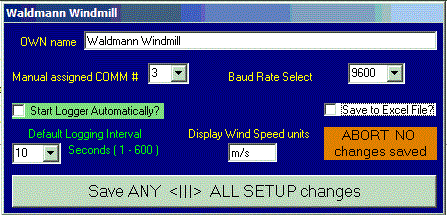
This is the screen for channel setup. 
This is for setting up personal logging XML identifiers. 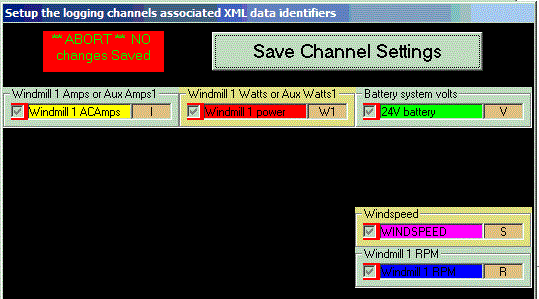
This is for setting up initial preferred channels to graph. 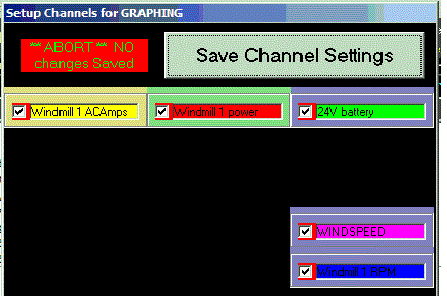
This is for setting preffered channels to display in real time. 
This is the calibration window. 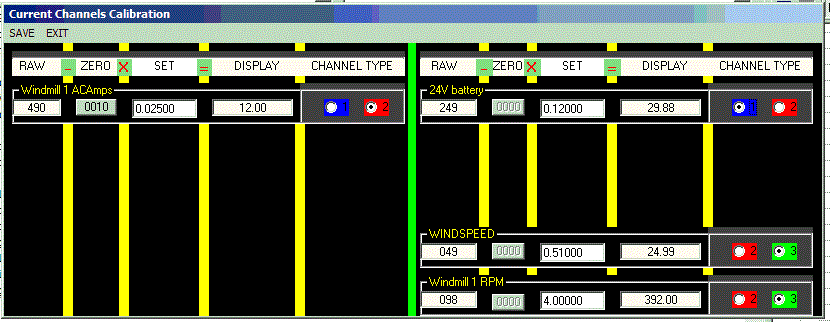
This is the RAW comm data display. Readers may have seen it on my little comm sniffer app. 
This is the windmill Power vs windmill RPM analyzer. 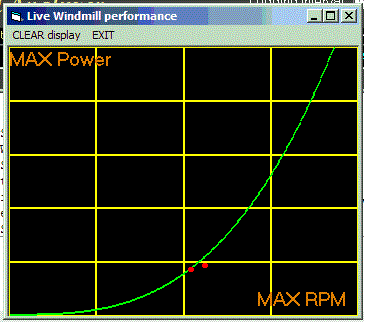
This is the VU type BAR graph display meter. 
This is the battery status indicator display. 
This is the maximum/minimum for the day window. 
This is the Graphing window for viewing historical logged data. 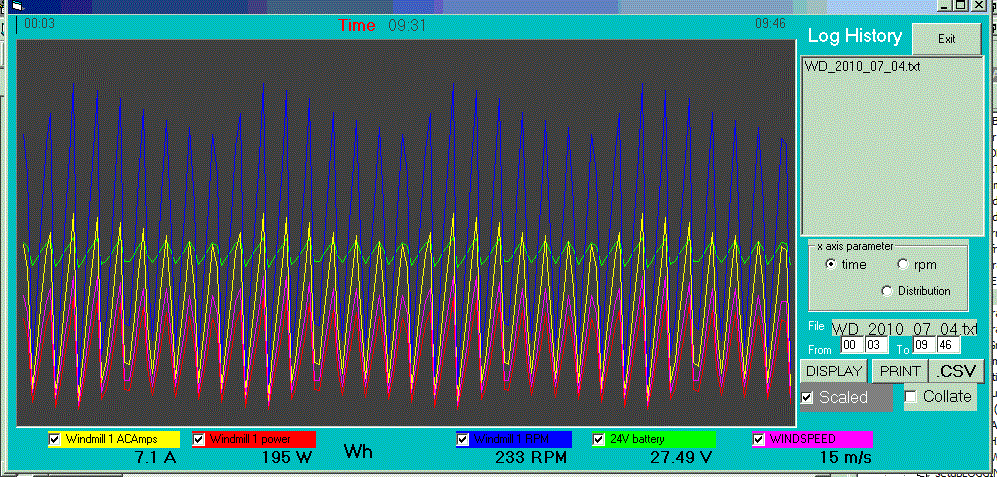
Screen Real estate becomes a problem when many data channels are to be concurrently viewed. I have redesigned the data fields to allow a single field to be used to display up to 3 different readings, depending on how the pointer is used. With the pointer say over the graph, then the readings reflect the data for that particular time for each channel. The maximum or minimum for the graphing window is available by clicking on the desired parameter output window. This has allowed me to view up to graph and view 12 individual channels with the same size window. A zoomed in portion of the graph can be viewed, and the maximum and minimums are recalculated, as well as the WH for the time period. I have tried to allow the user as much cutomizing as possible. Channel names and colours in all setup screens and graphing windows reflect user settings. The main display is fixed, as certain user colours are harder to view. The application will make all the configuration and help files and folders when first run. VB run files are still required and are the same as those needed by piclog. The application allows multiple windows to be opened and moved to suit personal prefernces for placement on the desktop. This has become a mammoth individual project and I hope to soon have at least the DEMO available. Gordon. become more energy aware |
||||
AMACK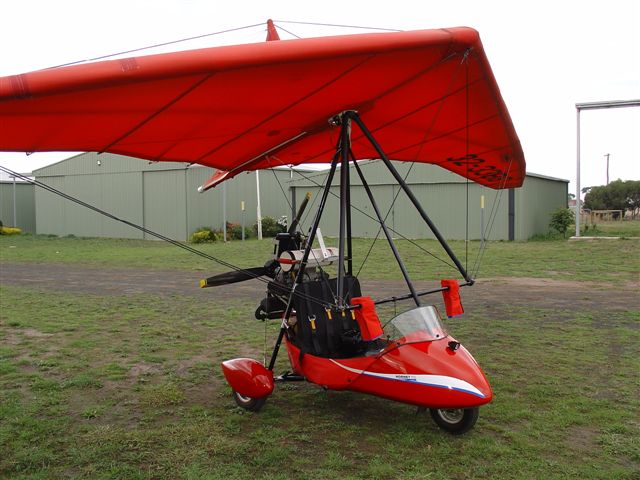 Senior Member Joined: 31/05/2009 Location: AustraliaPosts: 184 |
My GOD do you sleep. 
Looks like alot of work, well done. 
You must be dedicated to the task. I think this program has it all but I think you missed one thing, the Kitchen sink. 
I really like the Power V RPM you can get real time look at the wind gen. All I can say is well done, I take my hat off to you Gordon. Andrew P.S Gordon I would love a copy to use with my new wind gen from Phill and the Data logger from Pete(downwind) *Note to self 1. Make it thick 2.Make it heavy. 3.Make it stronger than it should be. 4. Don't rush the first job as the second job will cost more and take mor |
||||
Downwind Guru Joined: 09/09/2009 Location: AustraliaPosts: 2333 |
It is a great effort and amount of work Gordon has put into this. If the rest of you seen the amount of versions and changes to form this has taken it is truly mind blowing (I have lost count on how many demo versions i have tested) This is a very powerful package for data logging. It can be a little tricky to get all setup and calibrated but very user friendly there after. I feel this will be a big asset to the forum and all who use it. Well done Gordon   
Pete. Sometimes it just works |
||||
| GWatPE Senior Member Joined: 01/09/2006 Location: AustraliaPosts: 2127 |
Hi Pete, the radio link looks like a handy companion to a logger, even though I would probably restrict use to a remote battery status indicator initially. Hi Andrew, the intention was to supply the software with the kit, but I am runing a bit behind. Here is a cluttered screen shot of how things could be. I am running a test program and not real data here. 
By breaking the screen down into smaller windows that can be positioned anywhere allows the user to determine what is needed. Some care was taken in behind the scenes coding to keep things in order though. To save cluttering the main window, each of the measurement output displays has multi functions. When the cursor is clicked on say, the voltage, then for each click, the maximum or minimum for the day is displayed for a short interval, between data updates from the logging hardware. This has saved so much data display and identification space, and has allowed me to use larger fonts, so I don't need my glasses to read the numbers on screen. I have provided this, in addition to a separate window with the collated data. I have tried to make the screen layouts clear. I have restricted some of the flexible aspects as making the programming too flexible would defeat a lot of the calculating aspects that I have included. I am running the program overnight to test another module, so a few more to go. I will be testing the final version with simultanous running of the same applcation recording at least 6 comm loggers. This should be a fair test. Gordon. become more energy aware |
||||
| GWatPE Senior Member Joined: 01/09/2006 Location: AustraliaPosts: 2127 |
I have been tidying up the demo windmill analyzer, and have an app that seems to function reasonably well now. This demo will work with standard piclog files, and can record data at up to 1 second intervals. As much as possible is point and click selection, with some user specific aspects will require keyboard input. Channel names, and specific site info for a program name[useful for multiple running applications in different folders]. I have not fully tested printing, but the background is changed to white, to conserve printing resources, so darker colours should be chosen for the channel graphing colours if printing on paper. I have tested on COMMs up to 38400baud. Ports have to be in the range 1-8. Here is the file link. 2010-07-16_235353_Windmill_Analyzer_DEMO.zip The file is a self extractor. The extracted file, should be placed in a new folder and then run. The application will create new files and folders. Any logged data from previous piclog sessions that is to be viewed, need only be placed into the corresponding logs folder that was created by the analyzer, or alternatively the analyzer program can be placed into the folder with the piclog, and then run. The analyzer will not create new folders, but will add new config files. The piclog data in the existing logs folder can still be analyzed, in situ. This program is provided as a tool for analyzing an aspect of a windmills performance, and can provide graphical information on wind power distribution recorded from the windmill, that relates to the windmill site. I have not provided any help files. There is a fair bit of info on the previous page re menus, and calibrations. I suspect that readers viewing old data, will be enlightened by the wind energy distribution that is recorded by the windmill. It will be interesting to see the sorts of graphs that readers obtain upon processing their recorded historical data. Gordon. become more energy aware |
||||
| JimBo911 Senior Member Joined: 26/03/2009 Location: United StatesPosts: 262 |
Fantastic work guys, my thanks to all involved. Dam good stuff!    Jim |
||||
| GWatPE Senior Member Joined: 01/09/2006 Location: AustraliaPosts: 2127 |
Hi Readers. I would appreciate that any readers who choose to use this program, at least present some of the data from their own windmills. At least the daily windmill power distribution and the performance graphs from windmills all over the planet would be of interest to many fellow windmill enthusiasts. There is also a file called whours.txt, that is created in the logs folder, that recordes the daily watthour at widnight during automated logging sesions. This will be useful to those readers checking long term performance of their windmills. The program recalculates the daily whours from stored data, if the program is stopped and then restarted for some reason so this recording will be reasonably accurate for recalculating whours from the data that has been recorded. It cannot make up for lost data, or if the logging was not enabled, and the program was stopped. The whour record will still update at midnght with the displayed whours, even if the data is not logged though. The bulk VB6 programming was by the royal WE, me. I have had input from Downwind,[Pete], and fillm, [Phill] with some testing and I have incorporated a mix of my own ideas and theirs, to give some more universal balance to screen layouts and content. Users should check out clicking on displayed numbers, as I have tried to incorporate maximums, and or max/minimums in the same space, that is viewed by multiple clicks, between display updates of incoming data. There is also a screen for daily maximums and battery minimum. There are some gaps in many of the windows, and this is not an error. I have removed unnecessary functions, to avoid complicating the app for most users. I would like to thank Gizmo[Glenn], for allowing the publishing and distribution of programming ideas like mine on this site. I do hope readers take the opportunity to feedback some of their own windmill data. Gordon. become more energy aware |
||||
| VK4AYQ Guru Joined: 02/12/2009 Location: AustraliaPosts: 2539 |
Hi Gordon I would like to say how much I appreciate your work and perseverance in getting this project to fruition, I now look forward to being able to test and graph the results of some of my experiments. All the best Bob Foolin Around |
||||
| GWatPE Senior Member Joined: 01/09/2006 Location: AustraliaPosts: 2127 |
Hi Readers, I am still around. Still not happy over being dumped from the piclog testing program. I have been extending the capabilities of a logging application I made for the CurrentCost power meters, these last few months. I have incorporated real time update of the graphing and a calendar viewing mode of the stored files. I am now working on a log file data compression app extension and a rapid graph plot history recall. I have found that once the data library becomes extensive, that the file list view method I had been using became a little tedius[>100 files]. This was still better than manual filename keying in selection. The calendar view mode updates a calendar of the selected month with the files that are available that could be viewed during the month. This includes a distinction between daily records and hourly records. The windmill analyzer app can create either hourly or daily logged files. I have found that during testing phases of a windmill that faster recording rates provide extremely valuable data. The rapid finding and viewing and analyzing of this historical data is essential during the windmill setting up phase. This could be blade adjustments, or furling, or output load matching, including caps, or electronic maximizing component setting or calibrations. I found that logging at up to 2 readings per second helped. The all day logged files became unmanageable with more than 20000 records, so hourly files were the go. The calendar view file selection has user click selection of the month or year, and the selected month will be displayed so a date can be clicked. Days without data are clearly distinguished, so valuable time is not wasted clicking on dates without data. Only dates with data have a clicked outcome. I find that having to open a separate window to selectg a file to view is OK for a few times, but browsing historical data involves viewing many more days data and having the files available to click on without covering the graphs, makes day comparisons clearer. I have also found that redrawing a graph from scratch makes it harder to see day to day changes. I use a double buffer type display update. The display blinks with the new data updated. The scrolling graphical display shows an automatically updating graph of a user selectable time period of either the data for the current day, or the last hour, or even the last half hour, of the current days logging. I have found that it is really useful to be able to visually see the data for the time period just before when you arrive at the computer, to look at what the windmill had just been doing. The function operates for the current day only, and does not extend to future days yet. It is however a simple matter to just click open the newer current days log file and the updating restarts. I have cleaned up the display window, and have have found that the menu system as used by most commercial programs gives a clean look to the window. I am working on a dynamic view list window so the calendar mode or file list modes are only visible when needed. The object is to make my apps suitable for a touch screen, and so no keyboard or mouse is needed. Still a while OFF yet. Gordon. become more energy aware |
||||
Downwind Guru Joined: 09/09/2009 Location: AustraliaPosts: 2333 |
I must agree, as i have been lucky enough to preview Gordon's latest changes and it makes operation very simple. The live graphing function is GREAT as the new data scrolls across the screen as you are viewing, just like watching a heart monitor in a hospital. It really makes static graphs look very 1950's compared to live graphing. This has become a powerful logging tool for serious data collection and Analise. Pete. Sometimes it just works |
||||
| Gizmo Admin Group Joined: 05/06/2004 Location: AustraliaPosts: 5162 |
For that much data you should be using a database instead of text files. Text files are fine up to a point, but for any more than 10,000 records a database is the only way to go. A Access database will handle gig's of data easily, and you have the big advantage of using SQL queries to filter the data much quicker than using individual text files. Instead of 100's of text files you only need one Access file, so the user doesn't need to open any files, they just search by date or whatever and the software does the rest. It also means you can easily do things like ask the database for the highest watt peak this year, find the average wind speed for the month of May, etc. VB6 will work with most database formats like Access, dBase, and if you wont real scalability you can go to SQL Server. Stay away from the Excel driver. I've used Access and SQL for a few VB6 applications and will only use text files for simple applications. You can store config data in the registry, but text files are handy because you can edit them if the program wont run. Many Windows applications use a Access database renamed, like MYOB and Wage Easy. The reason a database wasn't used for PicLog was to keep it simple ( in fact the very first PicLog did use a database, but I went to text files ). See if you use a database, you need to use a installer to make sure the MDAC drivers on the users computer are installed and up to date. Ideally you would also set up a ODBC, but its not necessary. The Piclog was meant to be simple, and not use a installer, the VB6 installer is notoriously buggy. Glenn The best time to plant a tree was twenty years ago, the second best time is right now. JAQ |
||||
| vasi Guru Joined: 23/03/2007 Location: RomaniaPosts: 1697 |
What about SQLite? Hobbit name: Togo Toadfoot of Frogmorton Elvish name: Mablung Miriel Beyound Arduino Lang |
||||
| GWatPE Senior Member Joined: 01/09/2006 Location: AustraliaPosts: 2127 |
Hi Readers, I am not prepared to enter a debate on 'DATABASES' as I did not complete databases 101, but, many databases are used in commercial applications and the more complex of these require a team of database administrators, so they must be OK in certain applications. I am not convinced that a 'DATABASE' is really needed in this instance, as the windmill analyser is a relatively simple program. The program does create some folders and configuration files, but does not modify the registry and is not an installed program. The text files that hold the logged information are handled under program control. The computer file structure is used as the filing cabinet, and could be classified as essentially a multiple component database of sorts. The automatic storing of logged data directly to a database, risks contaminating a database with spurious unchecked data. A 'DATABASE' is only as good as the data in it. The windmill analyzer program does not trap all spurious data. I doubt any logging program could be trusted to automatically store completely valid data to a 'DATABASE'. I have seen the results of automatic database updating in a 'LIMS'. Unfortunately the errors were not recoverable. To perform the task of the windmill analyzer, the 'DATABASE' would need to simultanously parse the data to the storage file and be able to work on say the last 3600 to 8000 data records in real time. My objective, as I outlined above, is to have an application that does not require a keyboard or mouse to operate. I cannot see how SQL filters and a 'DATABASE' could achieve this goal. A 'DATABASE' does have searchability, and maybe the parsing of data to one could offer a historical search facility. I do not thnk it would be too hard to convert the logged data to a format suitable for a database. I do have Windows Access, so a possible future project may be on. Here is a pic of a previous 20min live update graph. I flipped to calendar view just prior to screen capture, so this could be seen as well. I normally use scaled graphs, so day to day performance is clearly shown on the graphs. If automatic scaling is used, then day to day performance graphs can look the same. Readers may question what the Voltage is doing. This is the windmill output voltage, and not just the battery voltage. This shows that windmill current is supplied below the battery voltage and indicates operation of the cap doubler. 
The latest revision still in development is basically a scaled, gridded, graphing window with a menu structure. My latest NetPC has a small screen, so I am optimizing the window size for it, and buttons take up screen real estate. Hopefully the touch screen laptop will have higher screen resolution than my NetPC. I have to admit that viewing a live updated graphical representation is really cool. The simplest analogy would be the difference between a CRO and a multimeter. I will be taking a well earned break to a warmer place, so this will be it for a while. Hopefully my loggers just keep doing their thing while I am away. Gordon. become more energy aware |
||||
| The Back Shed's forum code is written, and hosted, in Australia. | © JAQ Software 2025 |